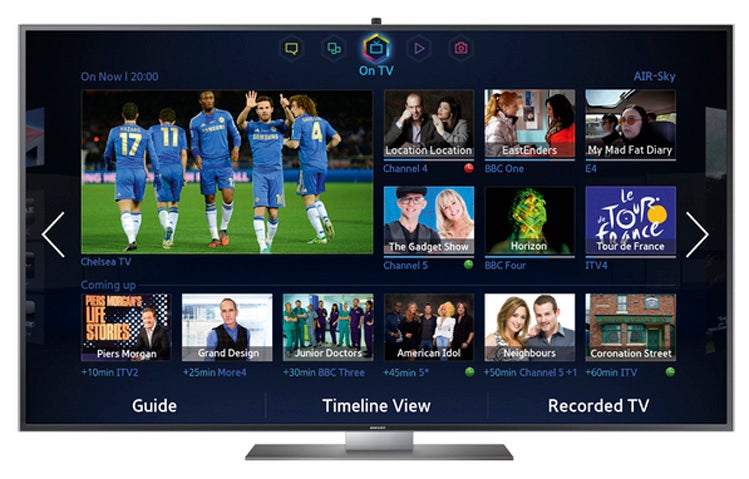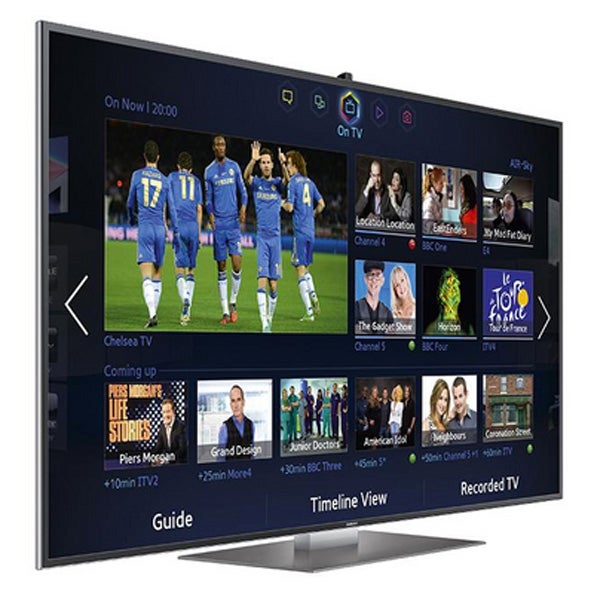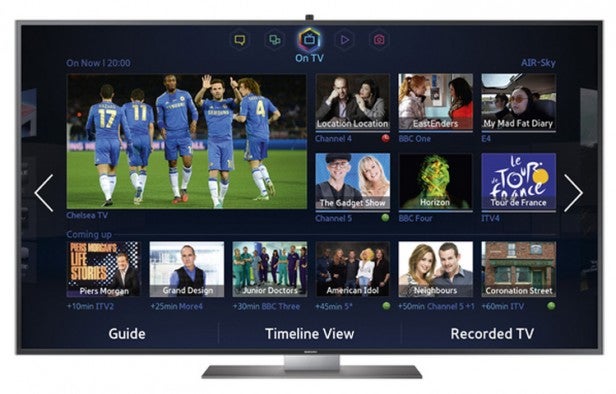Samsung UE55F9000 Review - 3D, Sound and Verdict Review
3D, Sound and Verdict
World Exclusive: Read the first review anywhere of Samsung's first 4K TV

Sections
- Page 1 Samsung UE55F9000 Review
- Page 2 Picture Quality Review
- Page 3 3D, Sound and Verdict Review
Samsung UE55F9000: 3D Picture Quality
The surprisingly different approach of the UK’s first two ‘mainstream’
Ultra HD/4K TVs continues when it comes to 3D. In short, where Sony went for passive 3D, Samsung has stuck with active 3D.
We were seriously impressed with the Sony KDL-65X9005’s 3D pictures, too. Unlike passive 3D images on
normal HD TVs, Sony’s 4K TV resolved a full HD level of horizontal detail, which combined with the fatigue-free benefits of passive glasses made watching 3D very pleasurable. Samsung, in other words, has a lot to live up to here.
And it doesn’t disappoint. While Sony’s
set made brilliant use of its 4K resolution to deliver an unmatched passive 3D experience, Samsung’s 4K TV upscales 3D inputs to deliver an Ultra HD 3D
experience. And the results are incredible.
Having so much resolution in a 3D image instantly makes the 3D world look more solid, more tangible and more immersive. In short, it makes watching 3D feel like you’re looking through a window at a real world rather than just watching 3D on a TV.
So profound is the impact of seeing 3D shifted up to an Ultra HD resolution that we ended up wasting an inordinate amount of time simply sitting through half a dozen of our favourite 3D test discs. And in every case there was a palpable feeling that we were watching these tried and tested discs for the first time again.

When you think about it, this Ultra HD impact on 3D makes perfect sense. For starters, we’ve already mentioned how a 4K resolution can improve the sense of depth you see in 2D images, so it follows that it will have the same effect on the perceived depth of 3D images. We’ve also noted how 4K resolutions can lead to colours being blended more subtly so that objects look more solid and ‘present’. And again it follows that this will have a pronounced impact on 3D footage.
The fact that Samsung’s upscaling engine is able to deliver such astonishing results in 3D mode is a true testament to the power and prowess of the UE55F9000’s processing engine.
We can’t leave the discussion of 3D, however, without mentioning the potential disadvantages of the active, full resolution 3D approach. But you’ll only see a trace of the active 3D flicker if you have your room lights set high, and the brightness and colour richness of the Samsung UE55F9000’s 3D pictures gives the lie to the idea that active 3D images have to look dull and colour-crushed versus passive ones.
When it comes to active 3D’s crosstalk double ghosting issues, the Samsung UE55F9000 is admittedly not totally immune. And when you do occasionally make out a ghostly echo of a (usually distant) line or object, it does diminish the staggering sense of detail and sharpness delivered by the UHD 3D effect.
But while the Sony 65X9005’s passive approach may be more relaxing, family friendly and free of crosstalk (so long as you keep your vertical viewing angle below around 13 degrees), the impact of the extra resolution on Samsung’s 3D images is hard to resist in our opinion.
The biggest catch with the UE55F9000‘s 3D performance concerns its motion handling rather than the usual active 3D problems. For without using any motion processing at all, judder levels in the image are alarmingly high. Using the Clear motion preset improves things a bit but not quite enough, while the Standard setting goes too far, generating some distracting flickering and halo artefacts over rapidly moving objects.
Fortunately we managed to arrive at a pretty solid solution by selecting the Custom motion mode and setting the Blur and Judder components both to ‘3’. Even then really tough 3D footage, such as the swooping camera movements at the start of The Hobbit, can still look slightly awkward, but it’s a big improvement on the standard settings.
Samsung 4K TV: Sound Quality and Gaming
Reluctantly tearing ourselves away from the consistently
blistering pictures, we have two more areas to cover: input lag and
audio. And actually, the set is slightly disappointing with both.
Our input lag measurements obtained a typical figure of 66ms, which is just enough to marginally reduce your performance with very time/reaction-sensitive games. Sony’s 65X9005A, by comparison, measured just 32ms of delay in producing its pictures.
The Sony 65X9005A’s audio advantage over the Samsung is more pronounced. The reason for the extremely wide wings to the 65X9005A’s left and right sides is that it uses them to hold a powerful array of front-firing speakers that use Sony’s new magnetic fluid speaker technology to produce levels of power and dynamic range that would previously have been unthinkable on a slim TV. By comparison, the Samsung UE55F9000’s speakers are rear mounted and much less powerful, so that the sound they produce is inevitably less potent and more compressed.
To be fair, though, if you compare the Samsung UE55F9000’s audio to other current flat TVs beyond the Sony, it actually sounds rather good, thanks to its wide soundstage, good harshness-free treble handling, and unusually open mid-range. A bit more bass would have been appreciated, but overall its sound is at least an adequate accompaniment for its mighty pictures.

Should I buy a Samsung UE55F9000?
If you want to both improve the look of your current HD sources and be ready for a 4K future that we’re increasingly confident isn’t very far away at all, then you should strongly consider buying a Samsung UE55F9000. It does an absolutely stunning job of rendering both native Ultra HD and upscaled HD footage, and its upscaled Ultra HD 3D images have to be seen to be believed.
Obviously, you can’t talk about the UE55F9000 without considering also the 65-inch Sony KDL-65X9005A and its 55-inch sibling, and there can be no doubt that Sony’s 4K rivals do an amazing job of bringing the joys of 4K home, especially thanks to their remarkable colour handling.
Having watched them side-by-side, it seems to us that the various strengths and weaknesses of the Samsung and Sony 4K sets make it impossible to say that one is better than the other overall. They will simply appeal to different people and tastes. Which in our opinion is about a good a result as prospective TV buyers could have hoped for.
Still not convinced by 4K? Head to our top 10 best TV round-up for our favourite ‘non-4K’ TVs.
Verdict
Thanks to the sensational efforts of the Samsung UE55F9000 – which proves comprehensively that Ultra HD remains very much a worthwhile technology even on a ‘mere’ 55-inch screen – the 4K juggernaut shows absolutely no sign of slowing down.
How we test televisions
We test every TV we review thoroughly over an extended period of time. We use industry standard tests to compare features properly. We’ll always tell you what we find. We never, ever, accept money to review a product.
Trusted Score
Score in detail
-
3D Quality 10
-
Value 8
-
Smart TV 9
-
Design 10
-
2D Quality 10
-
Sound Quality 8

